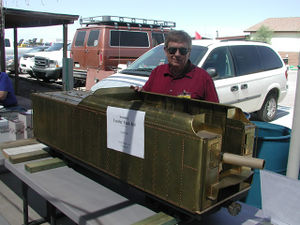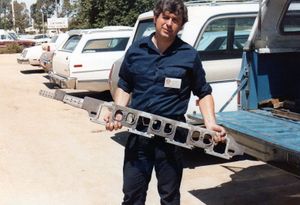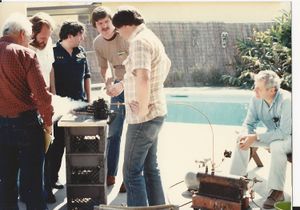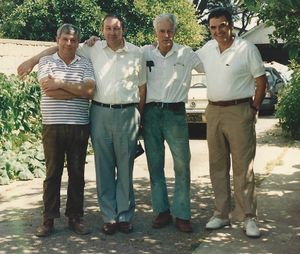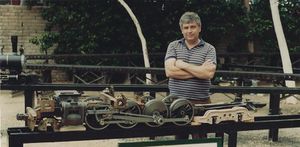Jim Kreider
Jump to navigation
Jump to search
Photos
Jim Kreider holding one half of a Berkshire frame at the IBLS meet, Los Angeles Live Steamers, 1980. Photo by Dave Sclavi.
Left to right.... Lew Soibelman, Jack Corrick, Jim Kreider, Tom Miller, Barry Hauge, Charlie Dockstader. Picture is from 1981. around a year of so before Tom's Big Boy was delivered.. Dick Bagley and I are out of frame. Photo by Algie Littlepage.
Jim Kreider, Brian Gittins (who created the PRR E6 Atlantic), Doug Alkire, and Mel Saslow of Saturated Steam. 23 June 1989, photo by Jim Kreider.
Berkshire
Jim Kreider wrote the following on Facebook, May 2018:
- The basic criteria that I used in designing the Berkshire was that all major force bearing frame castings were going to be ductile iron and the rest were going to be bronze. The only aluminum casting is the one-piece tender frame where weight was the determining factor.
- Mechanical characteristics of ductile iron show that it is, generally speaking, twice the strength of bronze.
- I discovered early on that I was able to get the best casting surface finish in bronze compared to either ductile iron or steel. Bronze melts around 1840°, ductile iron around 2100°, and carbon steel around 2500°. Certainly these metals are poured into molds at much higher temperatures than the actual melting points to give the metals a good fluid range so that they can fill a mold cavity, particularly thin-walled sections, before freezing or solidification takes place. This is easiest to do with bronze because of its lower melting temperature. In addition, the ”fluidity” of bronze in the mold is not hindered by the formation of oxides on the mold surface, compared to a ferrous material, so that a good surface finish and good detail resolution is more probable. Ductile iron would be next to have a good fluid range. Both bronze and ductile iron both have good “fluidity” in the mold due to low surface tension. Steel on the other hand, pours like mud with its high mold surface tension and therefore more “creative” use of gating and risers in the mold must be used. Thus the cost goes up and I did not feel that it was necessary for our application.
